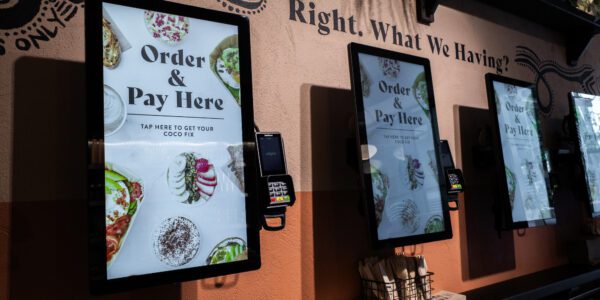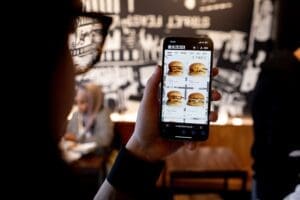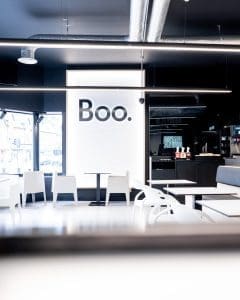7 incredible benefits of using self service kiosks in your restaurant
Self serve kiosks aren’t just for McDonalds any more. Discover the financial and operational benefits of kiosks and why they might be right for your restaurant.

Find out how you can tidy up your burger brand operations and give it the strong foundation it needs to grow, with solutions to seven top challenges for burger businesses.
Everyone loves a burger, which makes it one of the nation’s most popular restaurant categories.
But it’s also one of the most competitive.
Alongside this fierce competition, burger businesses are also facing rising costs of both labour and produce. If burger brands want any chance of setting themselves apart, boosting revenue and growing their business, they must solve operational problems that might be holding them back.
By solving these problems, operators can future-proof their business and build a foundation for confident growth in the long term – take Boo Burger, who increased ATV by 52% with the introduction of new digital order channels.
Here are our top tips to help you solve operational problems and grow your burger brand.

When thinking about growing your business, the first step is ensuring that your kitchen is actually prepared for the growth.
It might sound obvious, but if your kitchen is in chaos, it won’t have the capacity to accept increased orders, nor offer that high quality customer experience that keeps guests coming back.
So how can you guarantee that your kitchen is running smoothly and efficiently?
Most burger brands will be operating across multiple digital order channels like self-order kiosks, Click & Collect as well as delivery partners like Deliveroo.
Centralising all these channels into a single Kitchen Management System (KMS) ensures that every single order flows through the same system in the kitchen. No more tablet hell or kitchen chaos banished; order restored!

Burger businesses also need to make sure their KMS supports specific stations for all the different parts of the burger-making process, to make the fulfilment more efficient and calm for your back-of-house teams.
Are your Kitchen Display Screens customisable to your unique processes? Can they be easily colour coded for different kitchen stations, or so your team can easily identify where orders are coming from?
These are important questions to ask to make sure your kitchen can not only fulfil the orders you get now to the highest quality, but the increased orders as your business grows.
Beat the competition, confidently
Book a chat with a tech expert to discover how to make your burger business more profitable, efficient, and easy to manage – setting you the foundation for long-term growth.
We know how important it is to showcase the quality of your burgers when trying to get ahead of the competition. Digital order screens are the perfect place to showcase the premium quality of your food by using great photography.

But food photography isn’t the only way you can demonstrate your high quality – you can do it through the experience you offer guests as well. For a premium experience, the whole process needs to be sleek and frictionless. Quality should shine through in the tech you use, especially in the digital ordering UI. That great photography should be displayed alongside clear layouts and consistent branding.
With the rising costs looming over hospitality businesses, many restaurants are tempted to reduce their staff. But there is another way.
Cut inefficiencies, not people. This is how your people can do what they do best – be human. Each day, your staff have a full plate of admin tasks to get through, from taking orders to sorting third-party deliveries. But tech can easily take these tasks over. With the admin work under control and running smoothly in the background, your staff can focus on value-added tasks instead, like greeting guests or being on-hand to help them at kiosks.
That is how you save both costs and your customer experience.

Burger businesses can easily boost revenue through smart, customisable menus. By giving the option of additional ingredients like premium cheeses and sauces, or even bacon and gherkins, you can upsell and increase ATV.

You can even take advantage of basket recommendations – because who can resist a milkshake with their burger?
The proof is in the pudding: Bleeker’s smart menus increased sales of their sides and drinks by 141%!

Because burgers are so popular, diners have been served a myriad of different channels to order them. But different channels means different menus, and this can become a real kitchen nightmare for operators.
With centralised menu management, you can take all your menus from each separate provider, each individual channel, and each third-party delivery partner, and put them in the same system.
This way, updating menus across different accounts (a recipe for disaster) no longer takes hours, because you can update menu items quickly with one single update that syncs up to every channel. Perfect for launching that limited edition seasonal burger you’ve been working on!
Quick menu updates with new items keeps you ahead of the game, and efficient menu operating means you’re more than ready for growth.
When introducing new tech to your restaurant, it’s vital to think about where you’ll put it. In terms of self-service kiosks, this involves considering the queuing systems and collection points. The aim is to create an intuitive flow for customers that will reduce confusion and wait times. It should be clear where to order food, where to wait for it, and where third-party delivery partners should station themselves, too.

In the kitchen itself, consider which stations require specific KDSs to display relevant parts of orders. This is especially important in different stages of burger-making. With space planning, layout is strategically designed and staff can enjoy an optimised kitchen flow to work in efficiently.
A burger business is made up of many different parts, but they all depend on each other to work successfully.
For example, you can use digital menus to increase ATV, but this will only work smoothly if it’s in conjunction with an efficient Kitchen Management System, with KDSs at every station. You’ll also need easy-to-use sales data to help you identify the profit potential of different menu items.
If all of these elements are working together as one, you can streamline your operations, reduce wasted time and costs, and ultimately, fuel your growth.
How can you do that? With a single order management system.
You can deliver calm to your staff with just one central menu to update, one system to see every order from every channel, and one source for all your sales data – giving scaling burger brands the breathing space to expand. You can also give your guests the human experience they want, without compromising on scaling and growth.
Ready to scale your burger business? Book a demo and discover how you can increase revenue, operate more efficiently, and build the foundations for long-term growth.
Self serve kiosks aren’t just for McDonalds any more. Discover the financial and operational benefits of kiosks and why they might be right for your restaurant.

Learn the benefits of centralising your hospitality data, and how easy-to-read, real-time reports will help you scale your business.

Innovating Hospitality: Lessons from the Retail Sector
